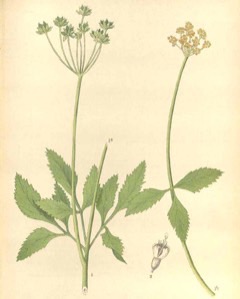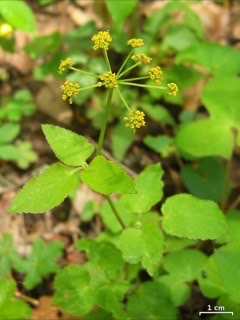 |
|
edibleplants.org |
 |
| Jason Hollinger wikimedia.org |
Translate this page:
Summary
Physical Characteristics

 Thaspium trifoliatum is a PERENNIAL growing to 1.2 m (4ft) by 1.2 m (4ft in) at a fast rate.
Thaspium trifoliatum is a PERENNIAL growing to 1.2 m (4ft) by 1.2 m (4ft in) at a fast rate.
See above for USDA hardiness. It is hardy to UK zone 5.
It is noted for attracting wildlife.
Suitable for: light (sandy), medium (loamy) and heavy (clay) soils and prefers well-drained soil. Suitable pH: mildly acid, neutral and basic (mildly alkaline) soils. It can grow in semi-shade (light woodland) or no shade. It prefers dry or moist soil.
UK Hardiness Map
US Hardiness Map
Synonyms
T. trifoliata L. T. trifoliatum var. trifoliatum
Plant Habitats
Edible Uses
References More on Edible Uses
Medicinal Uses
Plants For A Future can not take any responsibility for any adverse effects from the use of plants. Always seek advice from a professional before using a plant medicinally.
None known
References More on Medicinal Uses
The Bookshop: Edible Plant Books
Our Latest books on Perennial Plants For Food Forests and Permaculture Gardens in paperback or digital formats.

Edible Tropical Plants
Food Forest Plants for Hotter Conditions: 250+ Plants For Tropical Food Forests & Permaculture Gardens.
More

Edible Temperate Plants
Plants for Your Food Forest: 500 Plants for Temperate Food Forests & Permaculture Gardens.
More

More Books
PFAF have eight books available in paperback and digital formats. Browse the shop for more information.
Shop Now
Other Uses
Invertebrates shelter: beneficial for insects and other arthropods. Nectary: provides nectar or pollen for beneficial insects [1-2]. Insectory The nectar and pollen of the maroon flowers attract primarily flies and beetles such as dance flies (Empis loripedis). The caterpillars of two butterflies, Papilio polyxenes asterias (Black Swallowtail) and Papilio joanae (Ozark Swallowtail), feed on the foliage of Thaspium trifoliatum (Meadow Parsnip). An aphid, Aphis thaspii, sucks juices from the umbels of the flowers [1-6]. Woodland or native US plant gardens.
Special Uses
References More on Other Uses
Cultivation details
A long-lived Perennial in the parsley family. Prefers full sun to light shade, mesic (environment or habitat containing a moderate amount of moisture) to dry-mesic conditions, and practically any kind of soil, including those that contain clay-loam and rocky material. preferred Soil pH: 5.0 - 5.5. Bloom Time: May to July. Bloom Color: Yellow or Purple (depending on variety). Flower: Showy. For polyculture design as well as the above-ground architecture (form - tree, shrub etc. and size shown above) information on the habit and root pattern is also useful and given here if available. The plant growth habit is a clumper with limited spread [1-2]. The root pattern is a tap root similar to a carrot going directly down [1-2]. Thaspium trifoliatum has two varieties - var. trifoliatum, which has dark maroon flowers, and aureum, which has golden yellow flowers.
References Carbon Farming Information and Carbon Sequestration Information
Temperature Converter
Type a value in the Celsius field to convert the value to Fahrenheit:
Fahrenheit:
The PFAF Bookshop
Plants For A Future have a number of books available in paperback and digital form. Book titles include Edible Plants, Edible Perennials, Edible Trees,Edible Shrubs, Woodland Gardening, and Temperate Food Forest Plants. Our new book is Food Forest Plants For Hotter Conditions (Tropical and Sub-Tropical).
Shop Now
Plant Propagation
Seed
Other Names
If available other names are mentioned here
Smooth Meadow Parsnip, Woodland Meadow Parsnip, Yellow Meadow Parsnip, Purple Meadow Parsnip.
Native Plant Search
Search over 900 plants ideal for food forests and permaculture gardens. Filter to search native plants to your area. The plants selected are the plants in our book 'Plants For Your Food Forest: 500 Plants for Temperate Food Forests and Permaculture Gardens, as well as plants chosen for our forthcoming related books for Tropical/Hot Wet Climates and Mediterranean/Hot Dry Climates. Native Plant Search
Found In
Countries where the plant has been found are listed here if the information is available
Weed Potential
Right plant wrong place. We are currently updating this section.
Please note that a plant may be invasive in one area but may not in your area so it’s worth checking.
None Known
Conservation Status
IUCN Red List of Threatened Plants Status : Not Listed.

Growth: S = slow M = medium F = fast. Soil: L = light (sandy) M = medium H = heavy (clay). pH: A = acid N = neutral B = basic (alkaline). Shade: F = full shade S = semi-shade N = no shade. Moisture: D = dry M = Moist We = wet Wa = water.

Expert comment
Author
(L.) A. Gray
Botanical References
Links / References
For a list of references used on this page please go here
Readers comment
| Add a comment |
|
If you have important information about this plant that may help other users please add a comment or link below. Only comments or links that are felt to be directly relevant to a plant will be included. If you think a comment/link or information contained on this page is inaccurate or misleading we would welcome your feedback at [email protected]. If you have questions about a plant please use the Forum on this website as we do not have the resources to answer questions ourselves.
* Please note: the comments by website users are not necessarily those held by PFAF and may give misleading or inaccurate information.
To leave a comment please Register or login here All comments need to be approved so will not appear immediately.
|
Subject : Thaspium trifoliatum
|
|
|
|